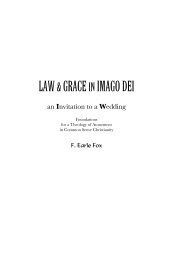Download entire 232-page book HERE (PDF ... - MassResistance
Download entire 232-page book HERE (PDF ... - MassResistance
Download entire 232-page book HERE (PDF ... - MassResistance
Create successful ePaper yourself
Turn your PDF publications into a flip-book with our unique Google optimized e-Paper software.
What is Homosexuality?<br />
Some people might be tempted to skip past this section because they think they understand<br />
this term. That is the first mistake made by every victim of “gay” sophistry. Failure to clarify the<br />
essential terms at the beginning allows one to be trapped by his or her own assumptions. It’s like<br />
signing a contract to buy a used car without clearly identifying the car.<br />
The definition of homosexuality is not as settled as one might think. Until 1986, homosexuality<br />
was almost universally defined as same-gender sexual conduct. By extension, a homosexual<br />
was defined as anyone who engages or desires to engage in such conduct. The “gay” movement<br />
itself embraced this definition, in which the term “homosexuality” had meaning only in relation to<br />
same-gender sexual behavior.<br />
After 1986, the “gay” movement began to redefine homosexuality as a normal and immutable<br />
condition equivalent to heterosexuality, a state-of-being completely independent of conduct.<br />
Under the new definition, “straights” can choose same-gender sexual relations and “gays” can<br />
choose opposite-gender relations without any alteration of their true “sexual orientation.”<br />
Why the change in strategy?<br />
1986 was the year that the United States Supreme Court, in the case of Bowers v.<br />
Hardwick, upheld the right of states to criminalize homosexual conduct. The “gay” movement had<br />
argued that homosexual sodomy should be viewed by the court as a fundamental privacy right no<br />
different than marital sexual relations. The court firmly rejected that argument in 1986, though,<br />
unfortunately, the constitutional right of states to regulate homosexual conduct was overturned in<br />
Lawrence v. Texas in 2003.<br />
Thwarted in its goal to legitimize homosexual conduct as a fundamental right, the “gay”<br />
movement turned to the only other basis on which it could claim constitutional protection:<br />
minority status as a “suspect class.” The Supreme Court recognizes minority status only for those<br />
groups which 1) have suffered a history of discrimination, 2) are powerless to help themselves and<br />
3) are defined by immutable characteristics.<br />
This is the secret to understanding why the “gay” movement now denies that homosexuality<br />
is behavior-based and instead insists that homosexuality is innate and unchangeable. It is not<br />
science. It is a legal and political strategy.<br />
The problem is that they can’t back up the claim. There exists no truly objective means of<br />
determining whether a person is innately homosexual. One cannot take a blood test or DNA test<br />
to prove that he or she is “gay.” We must depend <strong>entire</strong>ly upon a person’s claim that his or her<br />
homosexuality is innate. The taint of political self-interest alone makes such evidence wholly<br />
untrustworthy. Self-declared homosexuals can’t even prove that they sincerely believe that their<br />
homosexuality is innate. Instead, they argue that homosexuality must be innate because no one<br />
would choose to be “gay” and incur the resulting social stigma. This argument is invalid, since many<br />
people choose lifestyles that others condemn. Moreover, there are many homosexuals who freely<br />
admit that their lifestyle is a voluntary preference. This assertion is supported by a series of recent<br />
studies in Sweden, Denmark, Finland and the United States which reveal that the primary factors<br />
Redeeming the Rainbow 99






